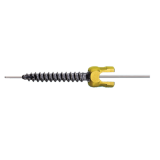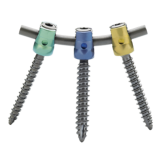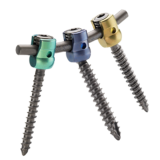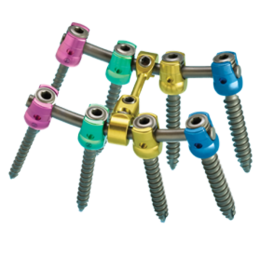Ürün Açıklaması
Zimmer Omurga adlı Başlığı 2 Poliaksiyal Spinal Sistem tek veya çoklu-seviye tespiti için çok yönlü bir çözümdür. Açık ya da minimal invaziv yaklaşım için izin verirken Straightforward enstrümantasyon, sıkıştırma, oyalama ve azaltma kolaylaştırır. Rehberli vida yerleştirilmesi gerektiğinde, Başlık 2 sistemi de kanüle Poliaksiyal vidaları ile kullanılmak için ideal bir seçenek sunuyor FlexPosure ® invazif işlemler sırasında daha az Portalı.
Özellikler
- Kap Kilitleme çapraz parçacığı için potansiyel azaltarak, bir kare dişli tasarıma sahiptir
- Sürtünme-fit kafaları yapı montaj sırasında istenmeyen geçiş minimize
- Agresif self-tapping kesme kanalları vida yerleştirilmesini kolaylaştırabilir
- Çok yönlü enstrümantasyon ile uyumludur FlexPosure Portal ve ARAS ® açık ya da minimal invaziv yaklaşım için izin Retractor
ZS-SA0700-27_A
Device Description
The TiTLE 2 Poly Axial Spinal System Implants are intended to be used as a temporary construct that assists in normal healing and are not intended to replace normal body structures. The system is intended to stabilize the spinal operative site during posterior fusion procedures, attaching to the spine by means of screws joined with spinal rods and should be removed after fusion. The components of the system are manufactured from Titanium that complies with ASTM F136 Standard for Ti 6Al-4V ELI. Some instruments supplied with this package insert are intended for single use only; refer to product label to determine if the instrument is intended for single use only. Refer to the Surgical Technique Manual for additional information on how to use these devices.
The System is equipped with components which are provided NON-STERILE. IMPLANTS ARE PROVIDED CLEAN AND MUST BE STERILZED PRIOR TO USE. INSTRUMENTS SHOULD BE CLEANED AND STERILIZED PRIOR TO USE.
Torque limiting instruments are designed to deliver a preset torque value when rotated in the clockwise direction. When the preset torque value is reached the instrument is designed to release. The handle will rotate approximately 30 degrees and the instrument is then reset to deliver the preset torque value again.
Indications
The TiTLE 2 Polyaxial Spinal System is indicated for degenerative disc disease (defined as discogenic back pain with degeneration of the disc confirmed by history and radiographic studies). Levels of fixation are for the Thoracic, Lumbar and Sacral spine.
The TiTLE 2 Polyaxial Spinal System is a Pedicle Screw System intended to provide immobilization and stabilization of spinal segments in skeletally mature patients as an adjunct to fusion in the treatment of the following acute and chronic instabilities or deformities of the thoracic, lumbar, and sacral spine: degenerative spondylolisthesis with objective evidence of neurologic impairment, fracture, dislocation, scoliosis, kyphosis, spinal tumor, and failed previous fusion (pseudoarthrosis).
The TiTLE 2 Polyaxial Spinal System is also indicated for pedicle screw fixation for severe spondylolisthesis (grades 3 and 4) at L5-S1, in skeletally mature patients, when autogenous bone graft is used, when affixed to the posterior lumbosacral spine, and intended to be removed after solid fusion is attained. Levels of fixation are from L3-S1.
In addition, TiTLE 2 Polyaxial Spinal System, when not used with pedicle screws, is indicated for hook, wire, and/or sacral screw fixation from T1 to the ilium sacrum. The non-pedicle screw indications are spondylolisthesis, degenerative disc disease, (defined as discogenic back pain with degeneration of the disc confirmed by history and radiographic studies), deformities (scoliosis, lordosis, and kyphosis), tumor, fracture, and previous failed fusion surgery.
The TiTLE 2 Poly Axial Spinal System can also be linked to the Minit® Posterior Cervical and Upper Thoracic Fixation System.
Contraindications
Contraindications include but are not limited to:
- History of recent infection, systemic, spinal, or localized
- Morbid obesity
- Mental illness
- Alcoholism or drug abuse
- Fever or Leukocytes
- Pregnancy
- Metal sensitivity / allergies to implant materials
- Severe Osteopenia
- Presence of congenital abnormalities, vague spinal anatomy, tumors, or any other condition which may prevent secure implant screw fixation and/or decrease the useful life of the device
- Any condition where the device will interfere with anatomical structures or physiological performance, including inadequate tissue coverage over the operational site
- For pedicle screw cases, missing or congenitally deformed pedicles of the fifth lumbar vertebrae
- Patients unwilling or unable to follow post-operative care instructions
- Any circumstances not described under the heading, INDICATIONS
Warnings
- The FDA has placed labeling limitations on this device.
- The safety and effectiveness of pedicle screw spinal systems have been established only for spinal conditions with significant mechanical instability or deformity requiring fusion with instrumentation. These conditions are significant mechanical instability or deformity of the thoracic, lumbar, and sacral spine secondary to degenerative spondylolisthesis with objective evidence of neurological impairment, fracture, dislocation, scoliosis, hypnosis, spinal tumor, and failed previous fusion (pseudoarthrosis). The safety and effectiveness of these devices for any other condition is unknown.
- When used as a Pedicle Screw System, this system is intended for Grade 3 or 4 spondylolisthesis at the fifth lumbar/first sacral joint.
- The benefit of spinal fusions utilizing any pedicle screw fixation has not been adequately established in patients with stable spines.
- Potential risks identified with the use of this device system, which may require additional surgery, include: device component fracture, loss of fixation, non-union, fracture of the vertebrae, neurological injury, and vascular or visceral injury.
Precautions
- The implantation of Pedicle Screw System should be performed only by experienced spinal surgeons with specific training in the use of pedicle screw spinal systems because this is a technically demanding procedure presenting a risk of serious injury to the patient.
- This device system is not intended to be the sole means of support. Its use without bone graft or in cases that develop into a non-union will not be successful. No spinal implant can withstand the loads of the body without maturation of a solid fusion mass, and in this case, bending loosening or fracture of the implant will eventually occur.
- Mixing of dissimilar metals can accelerate the corrosion process. Stainless Steel and Titanium components must NOT be used together in building a construct.
- No components of the TiTLE 2 Poly Axial Spinal System should be used with components from any other system or manufacturer, unless otherwise noted in the INDICATIONS section.
- The Delivery Instrumentation should be used to implant and connect the devices. The use of any other drivers, taps, or other instrumentation may compromise the integrity of the construct.
- As with all orthopedic implants, none of the TiTLE 2 Poly Axial Spinal System implants should ever be reused under any circumstances.
- Instruments designated for single use must not be reused and must be properly disposed of.
- All implants and some instruments are intended for single use only; refer to the product label to determine if the instrument is intended for single use only. Single use devices should not be re-used. Possible risks associated with re-use of single use devices include:
- Mechanical malfunction
- Transmission of infectious agents
- Using bent or damaged Guidewires can adversely affect Cannulated Pedicle Screw placement.
- Torque limiting instrument adjustment screws or caps with set screws should not be manipulated during the cleaning process. Manipulation or disassembly of the instrument will affect the calibration of the instrument and it will require re-calibration prior to use.
- Based on the fatigue testing results, the physician/surgeon should consider the levels of implantation, patient weight, patient activity level, and other patient conditions, etc. which may impact the performance of the system.
- The proper selection and compliance of the patient will greatly affect the results. Patients who smoke have been shown to have an increased incidence of non-union. These patients should be advised of this fact and warned of the consequences. Other poor candidates for spine fusion include obese, malnourished, poor muscle or bone quality, and nerve paralysis patients.
Possible Adverse Effects
Pre-operatively, the patient should be made aware of the possible adverse effects of spinal implant surgery. Additional surgery may be necessary to correct some of these effects.
- Bending, loosening, or fracture of the implants or instruments
- Metal sensitivity to a foreign body, including possible tumor formation
- Skin or muscle sensitivity in patients with inadequate tissue coverage at the operative site, which may result in skin breakdown and or wound complications
- Non-union or delayed union
- Infection
- Nerve or vascular damage due to surgical trauma, including loss of neurological function, dural tears, radiculopathy, paralysis, and cerebral spinal fluid leakage
- Gastrointestinal, urological, and/or reproductive system compromise, including impotency, and or loss of consortium
- Pain or discomfort
- Bone loss due to re-sorption or stress shielding, or bone fracture, above or below the level of surgery
- Hemorrhage of blood vessels and/or hematomas
- Mal-alignment of anatomical structures including loss of proper spinal curvature, correction, reduction, and/or height
- Bursitis
- Bone graft donor site pain
- Inability to resume activities of normal daily living
- Death









